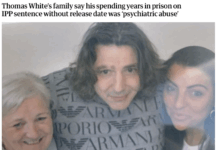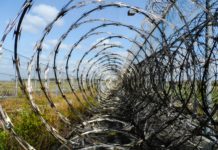“I will be fond of keeping still, and the people will of themselves become correct.”
—Tao Te Ching
The hot spring New Mexico sun pierces through razor wire stretched high above the opening of the rec yard of the Carrizozo jail. I sit with a group of men who serve long-term sentences for violent crimes.
Fear of other men runs deep here in our circle, here in the mad age of othering, here in a windowless building that looks like, from a distance, nothing more than a warehouse for storing things that no one else wants to deal with.
Our group gathers in the center of the jail’s basketball court under the only crack in the entire facility where a fleeting fresh breeze can connect us directly to the mad world of normal outside. Here, entrapped by four whitewashed cinder block walls, my long record of distrusting men is inescapable as my casted shadow catches me and scorches my ego upon the concrete below the high noon rays.

A corrections officer and student of mine, whose job is to restore the men, encircles us while placing tiny pins into all ten ears of the inmates. Guards observe with suspicion and a hint of curiosity which trumps their trance of boredom as a captivating swift and absolute silence ensues.
One officer whispers in my ear that he got this same auricular acu treatment a decade ago as a first responder after fighting a forest fire in the nearby White Mountain wilderness.
Thirty minutes later, the group awakes in unison. Eyes widen as their reflections unfold which tumble my fortified defenses against men bit by bit.
“I need this time to be able to heal myself,” says a tall, lanky former gang member whose face is dotted by tattoos.
Another man tells that he has survived the prison system since he was a juvenile, shipped from one institution to another, but this Lincoln County Detention Center is the only place that offered him more than just a cell, three meals, and a place to piss. “This is helping me focus on what I need to do with my life.”
Discussion diverts to owning our choices and getting our power back. I then lead a guided meditation, leaving the lockup for a practice of freedom, taking in the totality of this place where they have landed, this tiny town along the northern edge of the borderlands where a 22 year old boy in constant conflict with the law named Billy the Kid met his fate 140 years ago.
The visualization lifts us above the adjacent National Park and its volcanic spillway of charcoal from an explosion millions of years ago that permanently stained the desert floor. Sixty miles beyond this Valley of Fire sits the Trinity Site, where the first nuclear bomb committed its crime 80 years ago leaving the pumice poisoned, unforgiven and unpardonable by nature until 25,000 years from now.
Giving humanity another chance haunts our confluence, and is the idealistic cornerstone of this progressive project, here in one of the most politically conservative counties of New Mexico. Just west of the Texas panhandle, in the corner of the forgotten tail-end of the bible belt, the Mescalero Apache have taken up needles as an alternative to condemnation in a program staffed by the native people who seek to rehabilitate their own imprisoned Mescalero Apache people, who comprise the majority of inmates.
The program, known as RISE—Reach Intervention Support Engage—sprouted up in the middle of COVID which ravaged the local indigenous tribe. They walk with inmates through counseling, obtaining a GED, finding housing and transportation upon release, and even finance virtual collegiate studies. With a vision to transcend the cycle of incarceration into a restorative model of justice, rituals like smudging and cultural education are integrated alongside therapies like acupuncture, itself a technology that was invented by indigenous peoples of the Americas thousands of years ago.
The majority of their traditional medicines never survived the colonization and genocide in the US, but today many tribes use this unique ear acupuncture protocol known as acudetox. Recovery activists and Black Panthers in the 1970s experimented with ear points to arrive at a simple procedure that community health workers could safely apply it in underserved areas of the world. Acudetox arrived here to the Mescalero reservation in 2001. Although at that time, the state law forbade non-acupuncturists to apply this simple protocol, the tribe exercised their autonomy to govern themselves, defied state regulations and paved their own path to offer ear pokes. Their non-cooperation paid the pins forward. New Mexico acupuncture law opened right after in 2002. Now, 22 years later, in a region with no licensed acupuncturists, insufficient doctors and nurses, and in a county ranking sixth in suicide rate and alcohol-related injuring deaths, with the fourth highest rate of overdoses in New Mexico, today you can find acudetox offered in local drug courts, in the tribal hospital, as well as addictions care.
I was brought in by RISE to offer ongoing training and supervision for acudetox at the jail. I learned these methods as a counselor at Hooper Detox in Portland, Oregon where I worked with addicts mandated by the courts to get clean. After they stepped off the street and into the ward, the first thing offered to kick the heroin and alcohol dependency was to have needles placed in their ears. Witnessing this radically different paradigm needled me to teach as many people as I could how to replicate this ritual.
While finishing my last year of acupuncture school in Portland, I was invited to help start a service in response to violence in Ciudad Juarez, Mexico. Lacking any experience working in such a place, my insecurities almost stopped me from taking the leap out of the protection of the lush, liberal green Pacific Northwest and down to the blistering, barren aridity and political contrasts of the borderlands. One of my professors warned me that those people down there were not ready for acupuncture. I took a gamble.
Invited in by Church people, working class women and eclectic ecclesiastics, their dream of transforming their city’s tainted reputation as the murder capital of the world into the city of peace permanently planted me here. I perennially surprise my small self witnessing the hidden heroism of those people.
I saw Sunday school teachers aiding survivors of kidnapping and torture with acupuncture. I saw volunteers with limited education and no previous experience at all in healthcare help a man struck by a stray bullet learn how to walk again.
There won’t likely be a Netflix show about those types of everyday heroes in the land of narcos. Sitting in silence with needles would truly be a boring scene to film, but those people stirred me to the edge of my comfort zone. I saw a reformed gang member caring for survivors of the human rights catastrophe at a compound located on the far fringes of Juarez out in the desert adjacent to a dumping ground for discarded dismembered bodies.
Over the past 5 years, as hundreds of thousands of refugees sought asylum at the border I saw university students aid refugees hiding in sanctuary churches, evading the US government’s immigration enforcement. I saw nuns needling African and Latin American migrants sleeping on the bridge over the Rio Grande, right above the fuming stench of green toxic sludge from human excrement dumped down from US sewers north of the border.
As racism caught fire across the nation, inciting a young man to travel to El Paso to annihilate and terrorize Latinos and immigrants at a Walmart, just a mile from the free bridge to Juarez. I saw local military veterans set up a tent under the blazing 110 degree sun to offer acu care for survivors of the massacre.
Meeting these random but bold actors of mercy right in the middle of a deadly conflict zone definitively killed my fear of death, but also awakened my fear of conflict with others born of boyhood bully trauma in Wyoming. I left at 18, paranoid of getting stuck there, and my restless legs have had me running ever since.
A hundred miles north of Juarez, the abandoned town of Carrizozo feels spookily similar to the
boarded up ghost towns of my home state. The men stuck behind bars liberate me to revisit old stories. They remind me of men who have harmed me, those boys I grew up with, those guys I once called friends. Our shared stillness slackens my grip on the past. Each time we meet their curiosity digs a tunnel straight through the distrust I harbor:
What’s the best form of meditation?
When we awaken with courage to truth of the mad inside and the mad outside.
Where does acupuncture come from?
I read from Lao Tzu’s writings in the Tao Te Ching from eight millennia ago which sprouted the foundational wisdom for Chinese medicine.
“If you don’t trust people, you make them untrustworthy.”
Before I was trusted inside, I had to gain the trust of one man: The Warden. Measuring me up in his unusually small office, I prayed for some tiny bit of common ground to organically emerge. The answer came when an autographed football on a shelf behind his desk caught my eye, and I spotted an inroad for some self-effacing stories.
I took a risk and recounted my infamous high school quarterback career, leading my team to victory in the 1996 Wyoming Toilet Bowl, a game reserved for two worst teams in the state. I told him I blamed this dishonorable end to my anti-glory days on my excessively small linemen, a dedicated but insufficient group of tackles and guards, causing brutal sacks and repetitive injury and loads of lower back pain which prompted me to seek out an acupuncturist for the first time which eventually led me to Carrizozo.
His barrel chest bounced up to his chin as we shared a laugh. I sighed with relief.
With some ice chipping away, I knuckled down and shared statistics to back the concept. At one time, 90% of prisons in England had corrections staff applying ear acupuncture to reduce violence. I shared the story of how the first drug courts in the US used acudetox to reduce recidivism. I pulled out a packet of pins and proudly exhibited the flimsy 40 gauge things. He acceded that it would be hard for inmates to harm someone let alone dig a tunnel with the instruments.
That wasn’t enough. He wanted me to needle him. A deep breath dropped my projections. Here we go. Pins placed, I took a big step back with a sigh and surrendered my fingers to my back pockets as they micro-shook from the contending vibrations between my fear of steel bars caging me in contrasting my faith in steel needles stuck inside others.
“Do I look relaxed?” he asked, looking for validation as he snapped some selfies and his tight-lipped facade warped into a bright smile. I don’t know how, but acupuncture gets in there and opens people up. And makes me a believer again and again.
That day I met a man open to trying something new. I saw myself open to someone new.
Though the RISE program is only a few years old, I get to hear the anecdotes purporting its success in the prison system. The men locked inside say it helps them to trust the staff. Officers testify that the jail feels safer.
When I leave the Carrizozo jail to head home and one last whiff of stale metal sears my nose, the slamming of multiple gates behind me reminds me of the real-world separation between me and them. The two hour trip to Las Cruces affords time to distill the echoes of their allegory into my lectio divina.
Doing time gives me time to reflect on my past.
I wake up: My inside job is mine alone to do the time for.
Sitting here, I realize I have a lot of anger deep inside.
The ghost of my grandfather’s ambivalent relationship to anger shakes my skin.
The vulnerability of these men reveals me out of my delusion of a world in which mad is anathema. They expose me to the things we share as men; the trusting men thing, the anger thing. Our slick sublimation of emotions, our systemic side-stepping of authentic connection, our common roots in toxic masculinity.
But also our basic goodness inside; that too we share as men.
When I look in through their eyes, I see strength amidst susceptibility. I feel hope within desperation. Their courage challenges me not to give up on those I’ve given up on in my life.
Behind walls, outside walls, on either side of the border walls of this world, each of us spends our days pacing around the boundaries of our limited cells of influence, bearing our heavy weights of inherited and accumulated trauma and regularly compelled to reckon with our reliance on and rub with others that edge our spheres. Those people.
Sitting with my fear of men, as I sit next to these men, unmasks this truth: These are hard times for all of us to trust.
And it’s important we don’t stop giving it a try.
We end our group with loving-kindness meditation. We call to mind all we have met on our paths. Those people who let us down. Those we have let down. Those who hurt us. Those we have hurt. Those we have forgotten. Those who forgot us.
We bring to our hearts everyone on the outside, people who have the freedom that they can’t have—people like you and me—those people they may very well need to trust some time down some road if, by the grace of American justice ruled by white men, they ever climb out.
We pray for our sinful long-gone grandfathers. For our innocent far-away children. For our ever too close to home, sometimes Gorilla mind, often Monkey mind, doing the best with what we’ve got to walk our humbled walks just for today.
We repeat:
May you we well.
May you be happy.
May you be peaceful.
May you be loved.














